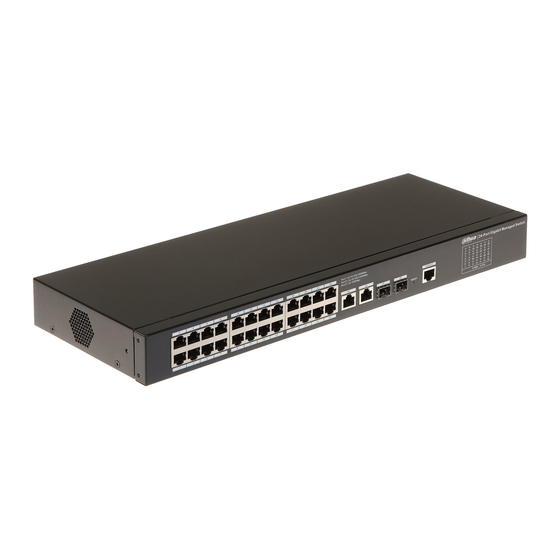
Table of Contents
Advertisement
Quick Links
Advertisement
Table of Contents

Summary of Contents for Dahua SG4028
- Page 1 16/24-Port Managed Gigabit Switch Quick Start Guide V1.0.0...
-
Page 2: Foreword
Foreword General This manual introduces the installation, functions and operations of the 16/24-Port Managed Gigabit Switch (hereinafter referred to as "the device"). Read carefully before using the device, and keep the manual safe for future reference. Safety Instructions The following signal words might appear in the manual. Signal Words Meaning Indicates a high potential hazard which, if not avoided, will result in death... - Page 3 All designs and software are subject to change without prior written notice. Product updates might result in some differences appearing between the actual product and the manual. Please contact customer service for the latest program and supplementary documentation. There might be errors in the print or deviations in the description of the functions, operations ...
-
Page 4: Important Safeguards And Warnings
Important Safeguards and Warnings This section introduces content covering the proper handling of the device, hazard prevention, and prevention of property damage. Read carefully before using the device, and comply with the guidelines when using it. Transportation Requirements Transport the device under allowed humidity and temperature conditions. Storage Requirements Store the device under allowed humidity and temperature conditions. - Page 5 Operation Requirements ● Do not disassemble the device without professional instruction. ● Operate the device within the rated range of power input and output. ● Make sure that the power supply is correct before use. ● Make sure the device is powered off before disassembling wires to avoid personal injury. ●...
-
Page 6: Table Of Contents
Table of Contents Foreword ................................I Important Safeguards and Warnings ......................III 1 Overview ................................ 6 1.1 Introduction ....................................6 1.2 Features ......................................6 1.3 Typical Application ..................................6 2 Structure ................................ 8 2.1 Front Panel ....................................8 2.2 Rear Panel ..................................... 9 3 Installation .............................. -
Page 7: Overview
1 Overview 1.1 Introduction Equipped with a high performance switching engine, the 16/24-Port Managed Gigabit Switch performs optimally. It has low transmission delay, large buffer and is highly reliable. It also has a strong switching capability and optimizes transmission performance when accessing Ultra HD videos. - Page 8 Figure 1-1 Networking application...
-
Page 9: Structure
2 Structure 2.1 Front Panel 16-Port Managed Gigabit Switch Figure 2-1 Front panel (16 port) 24-Port Managed Gigabit Switch Figure 2-2 Front panel (24 port) Table 2-1 Front panel description Name Description RJ–45 port Ethernet port, supports 10/100/1000 Mbps self-adaptive. 2 Ethernet ports, support 10/100/1000 Mbps self-adaptive;... -
Page 10: Rear Panel
2.2 Rear Panel Figure 2-3 Rear panel Table 2-2 Rear panel description Name Description Power socket Supports 100–240 VAC. Vent Improve the cooling performance. Ground terminal GND. -
Page 11: Installation
3 Installation 3.1 Installing the Device The device supports standard rack mount. Install the rack mount kit on both sides of the switch. Figure 3-1 Rack mount 3.2 Wiring 3.2.1 Ethernet Port Figure 3-2 Ethernet port pin number 10/100/1000 Mbps Base-T Ethernet port adopts standard RJ–45 port. Equipped with self-adaptation function, it can be automatically configured to full duplex/half-duplex operation mode, and supports MDI/MDI-X self-recognition function of the cable, which means that the switch can use cross-over cable or straight-through cable to connect terminal device to network device. -
Page 12: Console Port
Figure 3-3 Pin description The cable connection of RJ–45 connector conforms to the standard 568B (1-orange white, 2-orange, 3-green white, 4-blue, 5-blue white, 6-green, 7-brown white, 8-brown). 3.2.2 Console Port Figure 3-4 Console port The switch console port and computer controlling 9-pin serial port are connected with RJ-45-DB9 cable. -
Page 13: Sfp Port
Table 3-1 Pin description DB9 pin RJ–45 pin Signal Description Receiving data Sending data 3.2.3 SFP Port Background Information The signal is transmitted through laser by optical fiber cable. The laser conforms to the requirement of level 1 laser products. To avoid injury of eyes, do not look at the 1000 Base-X optical port directly when the device is powered on. - Page 14 There is a GND screw on the device cover board for the GND cable, which is called enclosure GND. Connect one end of the GND cable with the cold-pressed terminal, and then fix it on the enclosure GND with the GND screw. The other end of the GND cable should be reliably connected to the ground.
-
Page 15: Quick Operation
4 Quick Operation You can log in to webpage of the device via the following IP address. Table 4-1 Device factory default Parameter Description IP address 192.168.1.110 Username admin Password User Define... -
Page 16: Appendix 1 Cybersecurity Recommendations
Appendix 1 Cybersecurity Recommendations Mandatory actions to be taken for basic device network security: Use Strong Passwords Please refer to the following suggestions to set passwords: The length should not be less than 8 characters. Include at least two types of characters; character types include upper and lower case ... - Page 17 the risk of ARP spoofing. Assign Accounts and Privileges Reasonably According to business and management requirements, reasonably add users and assign a minimum set of permissions to them. Disable Unnecessary Services and Choose Secure Modes If not needed, it is recommended to turn off some services such as SNMP, SMTP, UPnP, etc., to reduce risks.











Need help?
Do you have a question about the SG4028 and is the answer not in the manual?
Questions and answers